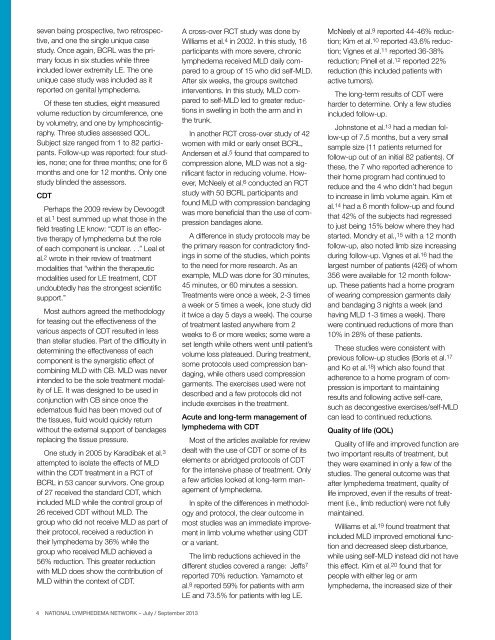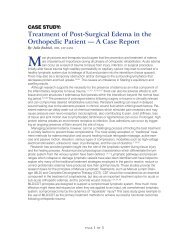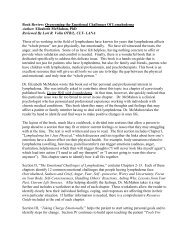Complete Decongestive Therapy - The National Lymphedema ...
Complete Decongestive Therapy - The National Lymphedema ...
Complete Decongestive Therapy - The National Lymphedema ...
- No tags were found...
Create successful ePaper yourself
Turn your PDF publications into a flip-book with our unique Google optimized e-Paper software.
seven being prospective, two retrospective,and one the single unique casestudy. Once again, BCRL was the primaryfocus in six studies while threeincluded lower extremity LE. <strong>The</strong> oneunique case study was included as itreported on genital lymphedema.Of these ten studies, eight measuredvolume reduction by circumference, oneby volumetry, and one by lymphoscintigraphy.Three studies assessed QOL.Subject size ranged from 1 to 82 participants.Follow-up was reported: four studies,none; one for three months; one for 6months and one for 12 months. Only onestudy blinded the assessors.CDTPerhaps the 2009 review by Devoogdtet al. 1 best summed up what those in thefield treating LE know: “CDT is an effectivetherapy of lymphedema but the roleof each component is unclear. . .” Leal etal. 2 wrote in their review of treatmentmodalities that “within the therapeuticmodalities used for LE treatment, CDTundoubtedly has the strongest scientificsupport.”Most authors agreed the methodologyfor teasing out the effectiveness of thevarious aspects of CDT resulted in lessthan stellar studies. Part of the difficulty indetermining the effectiveness of eachcomponent is the synergistic effect ofcombining MLD with CB. MLD was neverintended to be the sole treatment modalityof LE. It was designed to be used inconjunction with CB since once theedematous fluid has been moved out ofthe tissues, fluid would quickly returnwithout the external support of bandagesreplacing the tissue pressure.One study in 2005 by Karadibak et al. 3attempted to isolate the effects of MLDwithin the CDT treatment in a RCT ofBCRL in 53 cancer survivors. One groupof 27 received the standard CDT, whichincluded MLD while the control group of26 received CDT without MLD. <strong>The</strong>group who did not receive MLD as part oftheir protocol, received a reduction intheir lymphedema by 36% while thegroup who received MLD achieved a56% reduction. This greater reductionwith MLD does show the contribution ofMLD within the context of CDT.A cross-over RCT study was done byWilliams et al. 4 in 2002. In this study, 16participants with more severe, chroniclymphedema received MLD daily comparedto a group of 15 who did self-MLD.After six weeks, the groups switchedinterventions. In this study, MLD comparedto self-MLD led to greater reductionsin swelling in both the arm and inthe trunk.In another RCT cross-over study of 42women with mild or early onset BCRL,Andersen et al. 5 found that compared tocompression alone, MLD was not a significantfactor in reducing volume. However,McNeely et al. 6 conducted an RCTstudy with 50 BCRL participants andfound MLD with compression bandagingwas more beneficial than the use of compressionbandages alone.A difference in study protocols may bethe primary reason for contradictory findingsin some of the studies, which pointsto the need for more research. As anexample, MLD was done for 30 minutes,45 minutes, or 60 minutes a session.Treatments were once a week, 2-3 timesa week or 5 times a week, (one study didit twice a day 5 days a week). <strong>The</strong> courseof treatment lasted anywhere from 2weeks to 6 or more weeks; some were aset length while others went until patient’svolume loss plateaued. During treatment,some protocols used compression bandaging,while others used compressiongarments. <strong>The</strong> exercises used were notdescribed and a few protocols did notinclude exercises in the treatment.Acute and long-term management oflymphedema with CDTMost of the articles available for reviewdealt with the use of CDT or some of itselements or abridged protocols of CDTfor the intensive phase of treatment. Onlya few articles looked at long-term managementof lymphedema.In spite of the differences in methodologyand protocol, the clear outcome inmost studies was an immediate improvementin limb volume whether using CDTor a variant.<strong>The</strong> limb reductions achieved in thedifferent studies covered a range: Jeffs 7reported 70% reduction. Yamamoto etal. 8 reported 59% for patients with armLE and 73.5% for patients with leg LE.McNeely et al. 9 reported 44-46% reduction;Kim et al. 10 reported 43.6% reduction;Vignes et al. 11 reported 36-38%reduction; Pinell et al. 12 reported 22%reduction (this included patients withactive tumors).<strong>The</strong> long-term results of CDT wereharder to determine. Only a few studiesincluded follow-up.Johnstone et al. 13 had a median follow-upof 7.5 months, but a very smallsample size (11 patients returned forfollow-up out of an initial 82 patients). Ofthese, the 7 who reported adherence totheir home program had continued toreduce and the 4 who didn’t had begunto increase in limb volume again. Kim etal. 14 had a 6 month follow-up and foundthat 42% of the subjects had regressedto just being 15% below where they hadstarted. Mondry et al., 15 with a 12 monthfollow-up, also noted limb size increasingduring follow-up. Vignes et al. 16 had thelargest number of patients (426) of whom356 were available for 12 month followup.<strong>The</strong>se patients had a home programof wearing compression garments dailyand bandaging 3 nights a week (andhaving MLD 1-3 times a week). <strong>The</strong>rewere continued reductions of more than10% in 28% of these patients.<strong>The</strong>se studies were consistent withprevious follow-up studies (Boris et al. 17and Ko et al. 18 ) which also found thatadherence to a home program of compressionis important to maintainingresults and following active self-care,such as decongestive exercises/self-MLDcan lead to continued reductions.Quality of life (QOL)Quality of life and improved function aretwo important results of treatment, butthey were examined in only a few of thestudies. <strong>The</strong> general outcome was thatafter lymphedema treatment, quality oflife improved, even if the results of treatment(i.e., limb reduction) were not fullymaintained.Williams et al. 19 found treatment thatincluded MLD improved emotional functionand decreased sleep disturbance,while using self-MLD instead did not havethis effect. Kim et al. 20 found that forpeople with either leg or armlymphedema, the increased size of their4 NATIONAL LYMPHEDEMA NETWORK ~ July / September 2013





